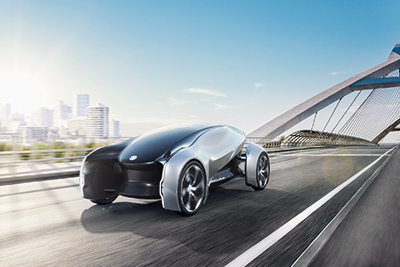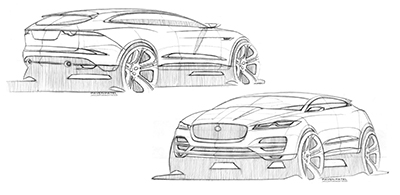|
|
||
|
Ian Callum, director of design at Jaguar, spoke to Icon following the brand’s appearance at Design Frontiers during London Design Festival An ambitious new show, Design Frontiers, spread over a goodly swathe of Somerset House at last month’s London Design Festival. Its sponsors, Jaguar, occupied two rooms exploring the testing realities and timescales of car design, revealing the extent to which design permeates the firm today. Icon spoke to director of design Ian Callum. ICON There seems to be an gap between the wider design world and the car design community – from a media perspective, the two don’t seem to overlap that much. Is there more going on from a professional perspective? IAN CALLUM Absolutely. I’ve got a lot of friends at the RIBA and I know the architectural process is very similar, so I can’t see why the design process, in any aspect, shouldn’t be too. I think there used to be a feeling, certainly when I started in car design, that it was very much about drawing pretty pictures of cars and somebody, somewhere, would then try and make them work – that may have been the case 30, 40 years ago. Nowadays, the designers get hugely involved in the planning, the make-up of the car – the packaging, the ergonomics – everything you can see, feel and touch in the car has to go through the design studio, and that involves a lot of disciplines. If you think of any other design activity, I can’t think of one in the world that actually encompasses what everybody else does, from textiles, to sheet metal, to the physics of ergonomics, to the feasibility of manufacturing. The design studio is really the engine room of that whole process, because it’s the one area where it all comes together as one piece.
Future Type ICON There’s a fantasy in many industries that ‘design thinking’ will infiltrate their processes. Do you think the car industry has gone quite far down that route? IC Yes, the car’s very being starts off the design process. Of course, we work with marketing, strategy, engineering – but ultimately, I’ve got the clay model. But that understanding of design – let’s call it ‘style’ – is just one fraction of the whole. Of course, our objective is to make the car look good, but it also has to look good within the parameters, which are very tough. But that is what any design process is about, whether it’s something as loose or indulgent as a work of art, whose function is to be enjoyed, right through to the most industrialised product in the world, which is probably the motor car. ICON Do you find yourself of necessity employing specialists, people who’ve been trained in car design, or do you infiltrate further afield to keep things fresh? IC We’ve got a lot of people who have been trained in car design, because it’s what they want to do – passion is a huge part of it. That passion delivers a huge amount of energy. I think if you look at the work output of what comes out of a car designer is because he or she loves doing it, is quite intense. But we have people from the textile business, from the shoe business, from product design, industrial design, people who used to design interiors for trains … we have really quite an eclectic mix. One girl was a watch designer. ICON The shoe business sounds an odd one. IC Surprisingly, it’s not. The shoe business, and Nike in particular, employ car designers because they have a much clearer flare for aesthetic, and are able to render it quickly. That’s the other thing that we do at Jaguar – I insist our people are able to draw things, because that’s their form of communication. A lot of other businesses in design tend to be a little more focused on the CAD modelling. We still go through the indulgence of drawing, and rendering, and expressing ourselves in an artistic way at the very beginning. Clearly that has to evolve into something that actually works, but the ideas have to go down on paper first. Inherently, the people in the car industry are good artists. They can draw ideas and thoughts very quickly. The sense of freedom and style offered by the shoe industry is quite enticing to some – we’ve lost a couple people to shoes recently. ICON The car industry is about to go through an enormous amount of change. Are you’re excited about that? IC Oh yes, I love it. If you look around the car industry, everybody’s scratching their heads thinking, ‘Well, what do we do next?’ If you ask a designer, it’s very obvious: you keep moving on quickly and you get on with it. You have to get on to this new era with confidence and optimism, otherwise you could drown in the possibilities of failure. ICON Is there a balance between being reactive and proactive? You don’t want to go down routes that end up costing lots of money and don’t end up as industry standards, but on the other hand you don’t want to always be behind the curve. IC As a car-design studio we have to be very aware of what our competitors are up to, where the world is going and where our customers are wanting to be in the future. You can gauge all that if you’ve got an open mind to listen to people. But we have to be proactive, and we have to be reactive as well. It is a fine balance, and time is crucial in this. The world’s about change, and the big guessing game at the moment is when is it going to change. Not if, but when. The zero-emission car is around the corner, but how far away is that corner? Autonomy is another one, which will have a huge effect on how we do things. And of course we have to keep a close eye on the wider economy as well – Brexit and the world market, and all the rest of it. That demands creative thinking, not just from a day-to-day product point of view, but the whole notion of what a motor car should and will be in the future.
Design sketch ICON Are you relaxed about keeping hold or finding young creatives in London, given that there are rather unpleasant times we’re going through? IC Well, actually it’s even more difficult for us, we’re in Coventry. We don’t even have the exotic lure of London. But we’ve got an eclectic mix of talents here. When I arrived, we used to get one portfolio every four or five months, and it wasn’t always that great. Now I’m getting at least a portfolio a week from all around the world. They want to come here not because of the country per se – they want to come and design Jaguars. We’ve made that seduction through product rather than culture. That’s partly because there’s more understanding and respect for the car industry than perhaps there was 30 years ago. Also, we’ve turned Jaguar from a rather old-fashioned car company into a very obvious brand in terms of design. But of course, design has always been at the heart of Jaguar, ever since it’s invention 80 years ago. Our founder William Lyons was a designer, and the first car man to be elected a Royal Designer for Industry by the Royal Society of Arts in 1954 – nobody else in the car business was given that award apart from Battista Farina. But I think London will survive Brexit. We all want to go and spend time in New York, and other great cities around the world. It’s a pain in the neck getting into the US through its emigration system, but we still go and do it. It’s going to be a bit of a hiccup, but ultimately it’ll find it’s level and designers will still want to come work in the UK – there’s something really quite unique about this country in terms of creativity. We’re a rebellious nation and people kind of appreciate that and love it, and I love it for that too. ICON What did you hope to get out of sponsoring Design Frontiers? IC I want people to understand our passion for design with a capital ‘D’ – it’s not just about cars. There’s a passion about how things are put together, how they’re made and detailed, and you see that right through in just about every function and every entity we get involved with. I want people to understand that, for Jaguar, design is very important, whether it be from a functional or an aesthetic point of view. And I want Jaguar to be part of that circle of aficionados who recognise good design around the world. I want it to be the car company that people see as design conscious, and doing something about it in a way that perhaps others are not. We’re not following the leaders, we do what we want to do, we’re generally creative. Of course we have constraints and inputs from the world around us, and the forces around us are getting stronger in terms of physics, chemistry, legislation, costs, finance and customers. It’s getting tougher and tougher, so I just want people to be aware that we’re aware that these things need solving. It’s very much part of our ethic and our culture at Jaguar. That’s why we got involved with it. We embrace other artistry in Jaguar, and Design Frontiers was part of it. |
Words Icon
Above: Jaguar Heritage E Type |
|
|
Future Type |
||






















